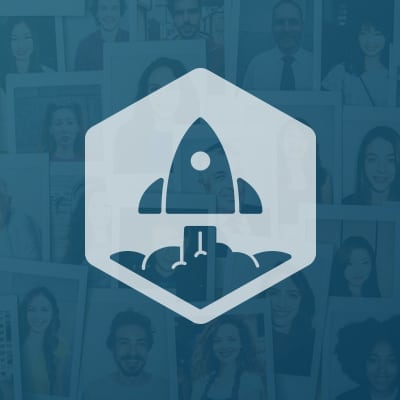We’ve done a ton of terrific sessions with the Twilio leadership over the years, including 4 different deep dives with Jeff Lawson, CEO and co-founder. The first time Jeff joined us might have been the most special. Twilio had just IPO’d and we were able to do a deep dive on the first $100m+ in ARR. How sales worked, how pricing worked, how billboards work, and more.
A look back at this great deep dive from SaaStr Annual 2017.
And if you haven’t heard: SaaStr Annual will be back in 2024, bigger and better than ever! Join 12,000 fellow founders, investors and execs for 3 days of unparalleled networking and epic learnings from SaaS legends from Sep 10-12 across 40+ open acres at the San Mateo County fairgrounds in the SF Bay Area.
Jason Lemkin: Let’s give it up for Jeff Lawson, very exciting. Thanks for coming.
Jeff Lawson: Thank you, Jason.
Jason: Yeah this is great.
Jeff: Thank you, everybody.
Jason: I learned a little lesson yesterday, let me make sure. Show of hands for people who have not heard of Twilio. Are there any here? Zero? I don’t have to ask Jeff to explain? You want to give 30 seconds for the two people on the top row?
Jeff: Yeah, I saw one.
Jason: You saw one? [laughs]
Jeff: Absolutely. Twilio is a cloud communications platform that allows software developers to embed communications into the apps that they’re building.
If you’re on text messaging, voice calls, video calls, authentication, even now wireless capabilities inside of apps, Twilio is an easy set of APIs that developers use to embed communications into their apps.
You use it all the time, you don’t even know it. If you take an Uber and you call the driver from inside the app, you’re actually using Twilio to make that call.
Jason: For you up there, that’s the answer of Twilio. We’ll learn more over the next little bit of time.
Before we do, I want to share one tiny, tiny, tiny story. I’m a founder. I founded two companies, selling to the enterprise. Somehow, we stumbled into this putting on some small events. You learn a lot about putting on events.
What happens, a lot of times, is some speakers can’t make it. It does happen. Sometimes, you get a random text. Sometimes, you get someone’s EA. Last year, we had a unicorn CEO whose EA said, “Unfortunately, a speaker was sick.” It was three months before the event, so she must have been prescient.
I will say, last year, Jeff was going to speak, and I got a message that he wouldn’t be able to. This was right around the press was saying, “Twilio might IPO.” I’m 95 percent certain the reason was this quiet period, when you have to go quiet to file an IPO.
He’s the only CEO that ever called. He said, “I feel so bad. I will find you a better speaker than me by tomorrow.” I’ve never heard that. I think that’s the kind of CEO that we all want to work for. It’s pretty cool.
[applause]
Jeff: I had nothing. I was like, “I hope he doesn’t take me up on that.” I have no idea…
Jason: I believe you would have made it happen.
Jeff: How I’m going to do that? I’m pretty sure Aaron Levie will do it.
Jason: We had him. He’s the ringer. I believe we’ve had him both years. Fortunately, Jay from Atlassian, right before the IPO, had said he’d love to speak. We had an extra slot. That was the first time I’ve heard it, so that’s a pretty special thing.
Jeff: I felt really bad, because you plan way ahead.
Jason: I’m kind of into that.
Jeff: You’re really good at that. I was fighting with our lawyers about, “Come on.”
Jason: I knew. I knew when I got a message that said nothing, I knew exactly this is…You go to lawyers. The first year we did it, Aaron Levie came one week after the IPO, in the middle of that. I didn’t think they’d let him come.
Jeff: That’s cagey.
Jason: I think he just told them, he was. [laughs] That will be my bet. First, congrats on the quarter.
Jeff: Thank you.
Jason: How long have you been public?
Jeff: This was our third quarter reporting.
Jason: One last quick question, then I want to get into it. What’s better, a Crunchie or coming to the SaaStr Annual? What would you say is the better award?
[laughter]
Jeff: They gave me a trophy. You know what I got? I got a sock from you.
Jason: You got socks and Taco Bell.
Jeff: Taco Bell backstage, it’s true. I don’t think Taco Bell is open at this hour, so I’m kind of curious.
Jason: I’m not sure how it happened.
I want to talk about a couple things we talked about before. One high level thing, I wonder, maybe you can…Twilio’s clearly the flagship of next generation, developer centric companies, first one to go IPO of this generation.
I know your marketing materials everyone…we talk about how the whole world’s more developer centric. As someone who has built and shipped software but doesn’t really code at this point, I’m still shocked the markets are so big.
Voice is huge. Voice is one of the largest markets out there, which is part of Twilio’s secret sauce of growing so quickly. For real, why is the developer market bigger today? Maybe it isn’t.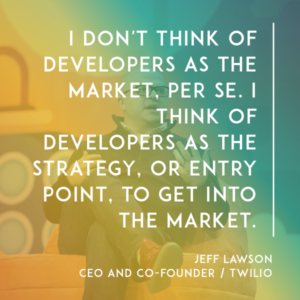
Jeff: I don’t think of developers as the market, per se. I think of developers as the strategy to get into the market for whatever you’re doing.
Jason: The entry point.
Jeff: The entry point. It’s a different entry point than you’re used to. At the end of the day, Twilio still sells communications, AWS still sells servers, but the way we’re selling it is different than how it was done in yesteryear.
Yesteryear, if you had a communications product, you would go into a relatively top down, IT type sale. You’d have an enterprise sales force, a song and dance and maybe some steak. That’s how you got a deal done.
Whereas, with the developer first approach, what you’re really doing is putting a new tool in the toolkit of the world’s developers so that when one day they’re at work, and they realize there’s some problem that needs solving, whether it’s communicating better with customers, adding two factor authentication to their app, or whatever it is, and they encounter a problem, they’re now able to say, “Aha! I know how to do that. Page Twilio.”
They pull out Twilio, and they can usually build a prototype in an afternoon. That’s faster, way faster than you can often get an enterprise sales rep on the phone. You actually ship the product before you could even start that enterprise sales process, in the traditional sense.
I think the developers aren’t a market as much as they are a vector to get into customers. That is just a much more efficient model than relying on, inside of Twilio, we call it the heroes’ sale. You know, the salesperson is going to come in with a great presentation and the amazing skills to work the room and therefore get the sale. This is just a very different model.
Jason: Today, your last third quarter, I think it was 75 million in GAAP revenue, something like that. Is that right?
Jeff: I should remember.
Jason: Something like that, so let’s call that $300 million dollar run rate, whatever it is. It’s probably higher than that after the math. Today at 300 versus…How much of your customers is the insertion point still the developers day one? Is it all of it? You’ve seen more CIO level pull or what’s changed there over time as you’ve gotten to scale?
Jeff: What’s interesting, as we’re working with bigger customers, traditional enterprises, etc., you do find that you’ve got more levels of organization who are interested and care and interested in that sale.
Jason: Or stakeholders?
Jeff: What we’re still finding, and this is fantastic, is that developers are the ones leading us into those scenarios. Developers are the ones who bring you in first, build that prototype and then it starts to snowball within the company, the momentum, because people see those things, “Oh, we want to ship that. What’s preventing us from shipping it?” “Well, it’s security, or it’s IT, procurement, or whatever.”
“Great. Let’s bring those people together,” and that’s where our sales force comes in, works the process through. Ultimately, we’re just trying to get something, typically the developer started through to production. If it’s a startup adopting Twilio, the developer does it, ship, they’re done.
Jason: They’re the decision maker.
Jeff: You don’t need sales. If it’s a complex enterprise, great. That’s where we shepherd…Oftentimes, we’re teaching the developer almost how to get through their own organization, but it’s still led by the developer and so you have this really nice tailwind as you’re going through the process.
Again, it’s not a hero sale. You’re not like, “Hey, let’s just do our RFP with five of our competitors.” It’s a, “Hey, the thing’s already built.” The executives may have even touched it and said, “Oh, this is awesome. Let’s get it shipped.” Now, we’re just trying to check the boxes that need to be checked in order to get something out the door.
Jason: Even today, at 300 million plus run rate, you don’t need to do top down sales at all. Even your most non techy customers, they’re still getting pulled in by developers?
Jeff: Yeah, it’s usually more of that bottom up…
Jason: You’ve got this brand now. How does the brand change things? In the early days, you were having to convince people they could trust Twilio. I assume that’s mostly faded away even with these multiple stakeholders.
Jeff: It’s interesting. We’ve got that Billboard on the 101. It says, “Ask your developer.” People often say, “Why do Billboard advertising anymore?”
Jason: It’s a good question too.
Jeff: [laughs] I think what it does is it provides air cover, let’s say, a developer builds a thing and they’re in some meeting where they’re saying, “How did you build this?” And they say, “Twilio.”
If you have name recognition, even though maybe I’m not thinking of those people as literally the first customers, most important that we hit, I want them to say as you did in here. “Oh yeah, I’ve heard of Twilio.”
Jason: I’ve heard of it.
Jeff: They’re trusted. “Aren’t they the ones who powered Uber? Aren’t they the ones who powered ING’s call centers? Aren’t they…” “Yeah, I’ve heard about that.”
You want that name recognition because I have to believe that that greases the process. Eventually, I think that CIOs and CEOs should care about communications as a strategic part of how they’re going to deliver on a great customer experience, which is ultimately the only way they’re going to survive.
I don’t care if you’re software business or you’re a bank or automaker, whatever it is, customer experience is going to be king and communications is almost always a major part of that customer experience. In the long term, I would love the C-level suite to say, “Yeah. We use Twilio because communications…How we communicate with our customers is actually important.” It takes time to build that kind of awareness absolutely, but right now I’d say it’s about that air cover.
Jason: I think we missed how important that’s air cover second and third touch are. We want to have heard of something we haven’t heard of, and that has a profound effect with the…
[crosstalk]
Jeff: I always thought about it as a…You know that NetSuite billboard?
Jason: It’s been there for a decade, yeah.
Jeff: I didn’t know what the hell NetSuite was. I was in some board meeting four, five years ago. It was like, when we were still on Quickbooks or something, whatever system I had setup. It was like, “OK, we need to get off that to our next thing and somebody, I think it was our CFO, said “Great, it’s either Intacct at that time or NetSuite.” I mean, it was like, “Oh ya, clearly NetSuite because they have a billboard.”
[laughter]
Jason: We laugh but it does matter.
Jeff: It works.
Jason: It doesn’t get the leads, it supports the leads.
Jeff: I didn’t question that decision at all. I’m like, “Oh, I, I’ve seen that billboard a lot. They seem to have a lot of good logos on it as customers.” That makes it so that when someone recommended NetSuite, it was like, “Yeah, makes sense.” I’m not going to challenge that or want to dig in. Like, “Yeah, it sounds good.”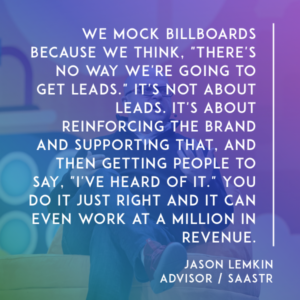
Jason: We mock a lot of this stuff like billboards, earliest founders because we’re like, “There’s no way we’re going to get leads.” It’s not about leads. It’s about reinforcing the brand and supporting that, and then I’ve heard of it. [laughs] You do it just right and it can even work like at like a million in revenue. [laughs]
Jeff: I think you’ve heard of it.
Jason: Yeah, it could even work.
[laughter]
Jason: Related to that, let’s talk a little bit for folks here. The insertion point’s still all developers, which is super cool, but as you add the stakeholder, how does that drive the changes in the product? We talked a little bit about SLAs and other things like that. How is, and two factor maybe even get three factor…How is going more up market change the product, or the products?
Jeff: Every company starts with you trying to figure out the utility you provide to your customer, which usually it’s not about, say, security and compliance and things like that because those things can block you from delivering utility from a customer, but you need to first figure out what utility you’re providing.
If you succeed in doing that, then you start reaching these customers that are bigger, more sophisticated, they know what questions to ask, they have compliance and processes they have to follow.
Jason: Did you go through phase where you failed every security audit, because a few of us have been through that in the audience? [laughs]
Jeff: One of my co founders was a security guy. We always had a good stance, but we didn’t have good answers to the checkboxes you would be like, “These are the stupidest questions. We’re way more secure…”
Jason: That’s what you hear from the guys that are too smart that they’re stupid questions sometimes.
Jeff: It’s because it’s the checkbox questions not the actual security questions, but we made it through that stage so we could actually say, “Yes, we are going to check the boxes in addition to actually being secure.” Of course…
Jason: They are related but two separate things.
Jeff: Yeah, and of course, like I said, it’s a never ending journey to security, no one ever says they’re secure. You have to go through this process where you start seeing these customers, and the first one you get, you be like, “Oh, silly customer with your processes.”
As you go on, you get more and more and more, then be like, “You know, we should probably…If we want to get this segment of customers, we should probably be investing in this roadmap.”
Most companies that are successful do go through that transition where you end up investing in quite a bit of those things, and as somebody, as entrepreneurs who are looking to make more revenue and figure out how to differentiate your customers in the price points, this is obvious. A lot of people have done this. It’s an obviously a great way to differentiate your pricing.
For Twilio, for example, we have got an enterprise plan. It adds things like single sign on and client certificate validation and a bunch of other security and compliance related things that clearly enterprises with a lot of check boxes because of their compliance requirements need to check. It’s a value added product. We monetize it separately.
It’s a monthly recurring revenue product, and actually one that our enterprise sales reps are regularly bringing in because it is a great way to go in the door. If you’re not willing to sign up for this monthly recurring package, then you’re probably not a very qualified opportunity.
Jason: It’s a great gate.
Jeff: Because with our usage based model, the prices at Twilio start at a penny, and you can sign up on our website and get going, and pay us as you go, and that’s fantastic. It’s hard to put an enterprise sales rep’s time towards a deal if literally our SKU costs a penny.
For us, it was a great way to distinguish between the types of customers that we have and also which customers need an enterprise rep because they have that kind of requirement set and those who merit our investment in an enterprise rep.
It’s a win all around. They get what they need, we get what we need, and we grow our business by delivering them the things that they need.
Jason: Do you find sometimes that that can be a slightly challenging cultural change? Especially, if you start up early, your super cool hacker culture, you’re doing cool stuff and all of the sudden, you’ve got to go more enterprise. Some of that stuff does not always seem fun to everybody.
Jeff: It’s surprised me. I’m a developer by my background. How many folks in here are sales by background?
Jason: Probably 25 percent.
Jeff: That’s a good number of people. Awesome. I’m a developer by background, and the thing that I’m always thinking about…How many of you are developers?
That’s probably an even split almost.
Developers, we often think about culture is really important about giving us freedom and do the creative energy which is developing and focus and concentration and big screens and all the things that we always think about as culture for a great engineering organization.
I never thought as much about the notion of the sales culture of an organization because I’m not a salesperson by my background. I thought that the cultural shift that happened was not so much a struggle for the developers.
It was actually an interesting struggle for the salespeople, especially the early ones we brought into the organization because they were the ones who in many ways were asking, “Hey, we want you to conform to this very engineering centric culture.”
Jason: Sales was driving a lot of that change.
Jeff: It’s not that they were driving it. It’s that we had to figure out how to build a great sales culture alongside a great engineering culture.
Jason: Without engineering viewing sales as some sort of tax.
Jeff: Yeah, imagine if you’re the first engineer inside of an all sales organization, you’ll feel a bit out of place probably.
Jason: It is hard, yeah.
Jeff: We just did it the other way, which is that we added a very engineering driven organization and introduced sales into it, and they were the fish out of water, and I felt that I had to go overboard as the CEO to let them know that I support them, that sales is important to our company.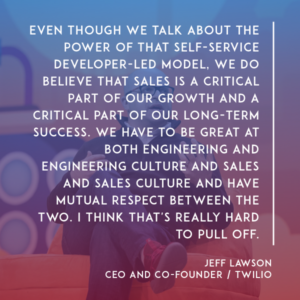
Even though we do talk about the power of that self service developer led model, we do believe that sales is a critical part of our growth and a critical part of our long term success. We have to be great at both engineering and engineering culture and sales and sales culture and have mutual respect between the two, and I think that’s really hard to pull off, and I don’t know a lot of companies…
Jason: It is hard to pull off.
Jeff: Google, you typically hear stories about how it’s all engineering led.
In Salesforce, you typically hear the story, “Oh, it’s all sales led,” and every company has this story about which culture is dominant, and it’s really hard to pull off, but it’s my goal that if you’re a salesperson, you should have an amazing sales culture and sales team to work with, and if you’re an engineer, you should have amazing engineering culture and amazing engineering team to work with.
Jason: Did you try and make the transition a little teal like with no quotas or best efforts, or did you move quickly to a traditional sales model when you added these folks?
Jeff: Our path to a sale model has been non linear because our model is quite different.
When you can sign up on the website and you publish all your pricing, you end up with a little bit different model than if the price list isn’t published. If our SKU literally starts at a penny with no minimums and pay as you go, it’s hard to say what sales…
Jason: Should do.
Jeff: …should do, and it’s hard to measure what sales is doing because you chronically ask this question, “Would we have made that sale anyway?”
Jason: Especially on people that buy more. They buy more minutes. They buy more usage. How much does a sales rep get credit for that?
Jeff: The usage, we have multiple vectors of growth inside of an account, but one of the most dominant ones is the customer built the thing and they roll it out, and as they roll it out and more and more of their end users use it.
With a usage based revenue model, we’re going to make more money on that account. The question is, do we have a sales rep who’s causing Airbnb to rent more apartments that’s driving more communications.
No. Clearly, we are irrelevant to that… they bought a super bowl ad. That’s what we like, right?
A sales rep didn’t cause that to happen. We’re always questioning. That took multiple iterations. I feel really good about where we are at right now. It took multiple iterations to figure out how do we separate the organic growth that happens with or without what we do from the inorganic growth that is what we’re investing in with a sales model.
Jason: It is hard.
Jeff: It’s really hard. We went through a lot of iterations about how to figure out to do that.
Jason: Yeah. Let’s talk about a couple…
Jeff: By the way, it is never good when a salesperson who’s like, “You know, I made the sale, I’m really awesome,” and then management is like, “Yeah, are you?” Constantly questioning the value. That was one of the challenges we had to get over [laughs] in building the sales culture and also defining the sale moment.
Every account at Twilio starts at a penny. Literally, every account spent their first penny at some point. It’s just a continuous stream from one penny to two, to 10, to 100, to 1,000, to 100,000 whatever. At what point, did the sale occur?
Jason: Yeah, I don’t know. I drew the line at 99 bucks a month. That’s what I allowed it.
Jeff: Most companies, there’s a, you’re not a customer and then you are a customer. It’s a step, fun…
Jason: Here, you just became a customer.
Jeff: Yeah, right. For us, it’s just a linear. I wonder where along the way you became the customer such that the salesperson can declare victory. It took a while for me as an engineer to figure out the sales game, it’s a game. You want to know when you’re winning the game.
Jason: You do.
Jeff: In our model, it was hard to tell you if you’re winning or not. That was a really interesting challenge that I think we had to figure out along the way.
Jason: To me, winning those models, it’s about whether the rep can inflate the curve. If you’d achieve the same amount of revenue without a rep, then you can do it all with happiness officers.
Jeff: It’s interesting because I’ve made a blind faith, I had for many years made a blind faith investment in sales. What I did is I look back at every major customer that I can look at. I can look at top 50 list or whatever.
I go through the list. A substantial number of them that I looked at and I’m like, “Wow.” When we were really small and even before we had a sales team or much of a sales team, I had gone in and almost every one of these accounts had sold. That’s how these accounts got started.
Jason: You’d sold?
Jeff: I did, the CEO.
Jason: You went there, you Uber’d over…
Jeff: At the same time, I would be like, “I don’t know if we need sales.”
Jason: You were doing sales?
Jeff: In the very early days, I was doing sales. When I realized that, I was like, “Wait a minute.”
Jason: The top 50.
Jeff: I am doing that. [laughs]
Jason: How many of them had you met in person, do you know?
Jeff: A lot of those.
Jason: A lot, so that’s sales.
Jeff: I was being a founder, and hustling, and meeting customers and hang, shaking hands and learning about their business and saying, “Hey, what if you did this or that? Hey, we can help you with that.”
I go back to the office and be like, “I don’t know if we need a sales model.” I got this realization one day, I’m like, “Wait a minute.”
Jason: That’s what I’m doing.
Jeff: Every major account that we have, it feels like I’m touching, I’m active, I’m giving them love and all that. I’m like, “That’s sales, OK, screw this.” [laughs]
Jason: Yeah. That’s a critical insight some of us missed.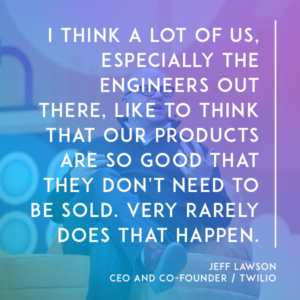
Jeff: I think a lot of us, especially the engineers out there, we like to think that our products are so good that they don’t need to be sold.
Jason: Yeah, that’s a tragedy when I hear that. It is true on occasion, but it is…
Jeff: Very rarely.
Jason: What’s that?
Jeff: Very rarely.
Jason: It’s hard to get the 300 million with the product selling itself.
Jeff: Even some products get started on their own. Again, if you really want to go deep in the customer, make a long term relationship, continue to go deeper and sell more and more things and be more meaningful with their business, that’s going to be a relationship.
Jason: And worst case, if you go visit them, you’re going to make more money from them or the other. The turn’s going to be lower. They’re going to have call Jeff before they leave the platform. [laughs] No one wants to do that.
Let’s talk a little bit about agility as a high level topic. As I have worked with more founders, I have learned I’m in love with founders and companies that are more agile than I was as a founder or CEO. Two things around Twilio.
One, we chatted about backstage which is multiple product lines. I was barely ever able to do one product line in my second startup. My first one, I was able to do more, but with Twilio, you launched with voice first and then SMS?
Jeff: Yes.
Jason: You launched, it’s a hack in the beginning with 18 months, you’ve got another product line? Is that the history?.
Jeff: Basically, we launched voice in 2008, very end of 2008. The number one thing we were hearing from customers was, “Hey, we’ve got these phone numbers we are buying from you through these voice calls. It would be really cool is if we could send or receive text messages with these phone numbers too.”
We said, “Yeah, it makes a lot of sense and I bet there’d be some cool stuff you could do.” About 18 months later, we launched Twilio SMS which was…I don’t think we exactly realized at the time. It was a completely different market. Completely different set of use cases…
Jason: Way different use cases.
Jeff: Yeah, really, a very different product line. For us, we were, A, just following our customers’ needs and B, we’ve never really wanted to be a single product company. I know there’s this advice that entrepreneurs often get about find a niche, get rich, focus, focus, focus.
Jason: Focus, focus, focus.
Jeff: There’s a lot of ways to phrase this bad advice.
[laughter]
Jeff: For me, it’s always been about every time you ship a product, it’s a bet. It’s a bet that the customers need the thing that you’re building. You know you didn’t get it right the first time, but with iteration, ultimately you will find something there, but you are digging holes trying to find oil or whatever, pick your metaphor. Besos had great one in their shareholder letter last year.
Jason: What was it?
Jeff: It was more at bats.
Jason: More at bats.
Jeff: He says every at bat has a chance to score a…
[crosstalk]
Jason: He does have a significant amount of scale though.
Jeff: He does have scale. He’s like, “Your goal is to just get more runners on the bases because every time you get a runner on the base, that’s an opportunity to score a home run.”
He has this great zinger at the end of it, he says, “But unlike baseball, where the best outcome you can have if someone hits a home run is four runs, in the world of business, your outcomes are unconstrained.”
A grand slam in business can be 100 million home runs. There’s no limit to how much you can, no ceiling to what you can achieve if you get a home run. I just believe that.
I think that it’s a probabilities game with all sorts of things, whether it’s starting your company or whether it’s your single, your product itself, there’s a probability to it. I’m also a really big believer in the power of a small team to build and operate a product.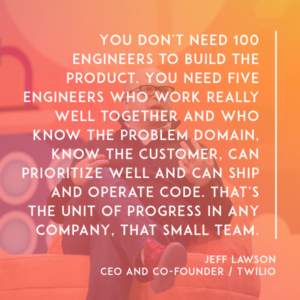
You don’t need 100 engineers to build the product. You need five engineers who work really well together and who know the problem domain, know the customer, can prioritize well and can ship and operate code. That’s the unit of progress in any company, that small team.
Jason: A group of five.
Jeff: For us, it was all about saying, “We’re not content with just having one bet out there. Let’s have more bets out there and then let’s continue to invest in them when they work.”
Jason: They are all discreet teams?
Jeff: Discreet team.
Jason: Engineering team.
Jeff: Yeah. Now as the products get bigger, like our voice product now is a much bigger product than it was back then, you end up breaking the problem down into many smaller problems. Our voice team isn’t one team anymore.
It’s many teams that each own parts of that problem. They have clarity about what they own, what customer they are serving, what success looks like. Even as you break down and as an API company, it actually becomes pretty easy to break down problems, because you’ve got different parts to the API that interact nicely together.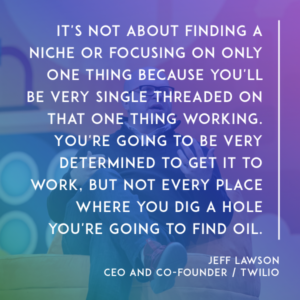
I’ve just always believed in this notion of, it’s not about finding a niche or focusing on only one thing because you’re very single threaded on that one thing working. You’re going to be very determined to get it to work, [laughs] but not every place where you dig a hole you’re going to find oil.
Jason: The five’s the rule. Put five folks on a project to build a product.
Jeff: 5 to 10.
Jason: 5 to 10. It was interesting. Yesterday, we had Michael Pryor from Trello who was at Fog Creek before. Trello began to consume all the resources of Fog Creek. Fog Creek was small. I was an old customer.
50 people and all of a sudden, 20 people at Fog Creek are building Trello. And then they have to spin it out. When do you shoot it? If you put 5 or 10…then it is more. How many employees is it at Twilio today?
Jeff: They’re about 730.
Jason: It’s big, but it’s not huge. SMS was probably obvious because it probably took off so quickly, but maybe it didn’t.
Jeff: It took off pretty quickly.
[crosstalk]
Jason: Took off pretty quickly. Are there initiatives you killed with those small teams?
Jeff: Well, it’s interesting. Yes and no. We’ve killed the teams, but maintained the products. We find another home internally for the product to live. We have never killed an API that we’ve ever built.
Jason: Thank God. I hate that. [laughs]
Jeff: It’s one of the key tenets of our company. We’ve got our still main API, the version on it is 2010.
Jason: You got to maintain it, don’t you?
Jeff: We just keep adding to the same API’s. We don’t make backwards incompatible changes. That’s really critical to building our trust with developers. You change your staffing, your resourcing, and you try to put your investments with the best opportunity for success is.
You manage your portfolio of investing in your core business to keep growing and scaling the key drivers in the business, but also making new bets. That’s how we think about it every year. At any point in time, we’ve got investments that are your shorter term, incremental roadmap for your main revenue drivers, then your medium term.
Clearly, we have customer demand. We have to build it and we have to get it out there in the right way, with this thing. You’ve got your long term long shot bets that you really have no idea if they’re going to work out or not. For us, it’s been about managing that portfolio even since we were quite small.
We would start new initiatives with one person and just say, “Hey, let’s try to ship a thing, see the best you can do and let’s just explore this new area.” When the whole engineering team was so small that the only way you could make an investment was one person or part of a person’s time. It’s still something that I think you have to do.
Jason: I love that. One related topic I want to make sure we can dig into. I’m not an expert, but I’ve learned a little bit from the sidelines. Voice is a challenging area. It’s mission critical. In some ways, achieving end user expectations is impossible.
I’m guessing with SMS, you can disguise any issue on service level. The SMS, if it’s a minute, if it’s 60 seconds late, does it matter? I mean it sorta matters.
Jeff: Every product has its own…
[crosstalk]
Jason: Voice is hard. How do you remain agile and try and have quarterly, monthly, daily, hourly releases and not break a mission critical application?
Jeff: That’s a really good question.
Jason: I’ve never figured an answer out to that question.
Jeff: That’s one that we’ve worked… We’ve spent a lot of time figuring this out. I’m really proud of where we are today. We have given a name to this. It’s called agility with resiliency.
The way we’ve sold it internally, and actually started talking about this externally as well, is that the goal of a high performing engineering organization is to remain agile but deliver resiliency at the same time.
A lot of companies mistakenly believe there’s a false dichotomy between those two. They believe that we can be agile, but we’re going to give on quality. Zuckerberg’s, “Move fast and break things.”
Jason: Yeah, we don’t even need a QA team. We’ll just roll back.
Jeff: Or the opposite, which is, “Hey, we are going to ship quarterly, and be really methodical about things, and make sure we get it right and ship quarterly.” At Twilio, we’re now annualized 18,000 production deployments a year. It’s about 100 a day.
Jason: Production deployments?
Jeff: Production deployments a day. It used to be a few years ago that when you plotted our production deployments against our incidents, they followed each other on the graphs. We had this very conscious moment a few years ago.
We said we either need to slow down our deployments, but we know that’s not best engineering practice or we need to figure out the root cause. We went about figuring out the root cause, solved a lot of problems about how to build resiliency.
Now, we can ship 18,000 times a year. We have a five nines available API and seven nines success rate of the request that we’re serving.
We’re really proud of what we’ve accomplished. How we’ve done it is I would say two things. Number one, the small teams approach is really important, because the small teams build the software and they operate it. There’s no throwing it over the wall to OPS, that kind of thing.
Jason: They’re responsible for it.
Jeff: Yeah, they’re responsible for it. They run the services, internally and externally, but the other key thing here is we’ve trained people. You can’t expect that one would just know how to build resilient things.
We’ve trained people and coupled that with platform services that they get to consume, internally, and made a big investment in our internal platforming so that teams who’re building product can ship fast and have a really good safety net that’s built by other teams over here who are building services as well.
We train everybody. We have a program we call OMM, the operational maturity model. Internally, it’s codenamed Iron Man. It’s six vectors, it’s things like testing, monitoring, alerting, security, architecture. What we’ve done is we’ve documented best practices, we’ve trained the teams, and then we test them, and then we retest them.
Jason: Against this OMM?
Jeff: Against the OMM model. What we’ve done is we’ve found every engineer wants to do a good job of this, but she doesn’t always know how to do it. What we do is we do a training model where we figure out, “OK, here’s how we do it here. Here’s what we figured out as best practices.”
We’ve actually started externalizing this. We started talking about OMM, we talked about at our conference last year. We started going into our customers, because they’re really curious, “How do you do this? We want to try to achieve this.”
We’ve started sharing a lot of our wisdom with our customers as well. The interesting model is also with our product lines. The product development life cycle starts with…A new product comes out, it’s an internal alpha, then it’s a developer preview, then it’s a beta, then it’s a GA. It used to be several years ago, a product got called GA because customers wouldn’t adapt to it if it was called a beta.
We called it a beta, we put it out there, and then we would hear feedback from customers. “We don’t want to adopt something that’s a beta when’s it going to be GA?” and we’d be like, “Hey, it’s GA now!”
[laughter]
Jeff: We were never quite comfortable with that. What we’ve figured out is what GA should be a signal of. It’s from Twilio to you, our customer, is that we stand by this as an operationally excellent product.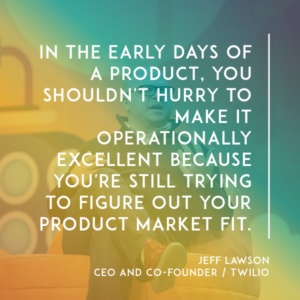
In the early days of a product, by the way, you shouldn’t hurry to make it operationally excellent, because you’re still trying to figure out your product market fit. Did we build the right thing? Let’s not harden it if we didn’t build the right thing.
Once you figure out that you’ve built the right thing, customers want it, now your job is to harden it. We’ve defined what that means, it’s this OMM, Iron Man model. Once you can check all the boxes, prove you have checked them to the engineering leadership of Twilio. That’s when you get to call your thing GA.
That’s how we’ve achieved this resiliency, by putting the tightened ratio loops where they need to be, then having a model where we train and check, and then call it GA so that our customers can expect operational excellence from products that have gone through that whole process.
Communicate what you do internally with your customers so they’re with you, right, if you’re a beta, here’s what that means.
Jason: We’ve got to convince someone on your team to write a guest post on SaaStr on OMM because I need to learn for everybody.
Jeff: Yeah, we’d love to do it.
Jason: It’s a good one. We’re over time, but one last question. What are you most excited about for this year, for Twilio? What are you looking forward to? What’s exciting?
Jeff: There is so much. We’ve got a lot of new product lines in the market, programmable chat, programmable video, programmable wireless. We’ve got a lot of really cool things coming down the line. In particular, I’m excited to hear what other communications problems we can be solving for customers.
In fact, I will tell you the thing I’m most excited about. Last year was a really crazy year. We had the IPO, of course. We had a follow on offering. I spent a lot of time with bankers, lawyers, roadshows, all those kinds of stuff. When I look back at the previous year, I feel like that was all very time consuming.
This year, I’m returning to spending a lot of time with customers. I’m going to meet with, at least, three customers a week.
Jason: I love it…
[crosstalk]
Jeff: …face to face, meetings with the customers. I asked the sales teams, “I want you to bring me in. I want to meet customers.”
When I get on a plane, it’s going to be to meet customers, not to meet investors, or to do PRs, or speaking gigs. I was able to walk over here, that’s why this is cool.
Jason: I appreciate it.
Jeff: Really focus on customers this year, because the process of going public, and all that…
Jason: Distracting.
Jeff: …can be distracting. I made a very conscious effort, but also set the tone for the company. We’re very customer centric organization. We strive to be, one of our core values is wearing the customer’s shoes. Again, I’d like to make sure that I’m wearing customer’s shoes as much as anyone in Twilio.
I’m excited to do that.
Jason: If Jeff can do three a week, I think you each can do at least two, don’t you think?
Jeff: Absolutely.
Jason: Pretty cool. All right, everyone, give it up for Jeff Lawson. This was amazing. Thank you very much.
[applause]
Jeff: Thank you.
Jason: Super cool. Thanks for doing this. It was great.
Jeff: Absolutely.

